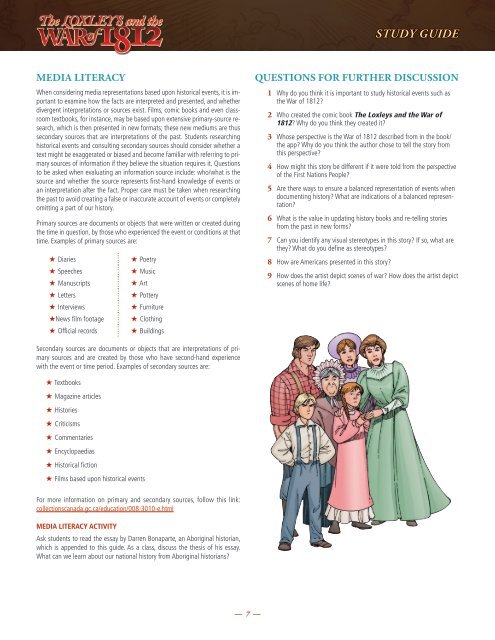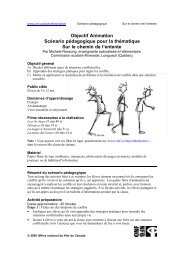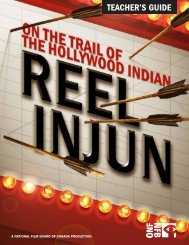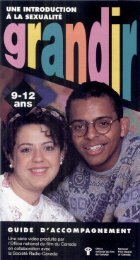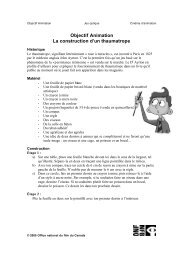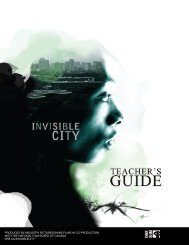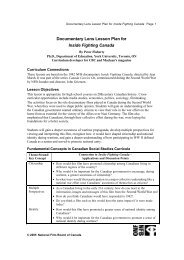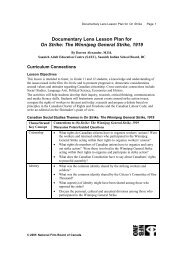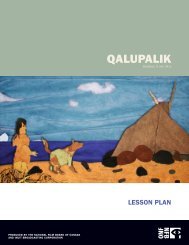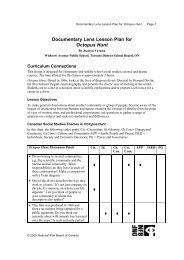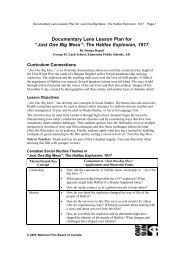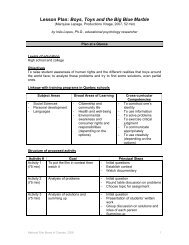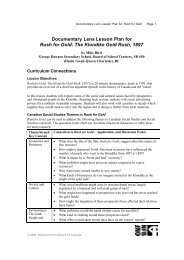STUDY GUIDECLASSROOM ACTIVITIESWRITE A SCRIPT AND RE-ENACT THE EVENTHave students work in small groups to write a short script about the Battleof Tippecanoe or another major topic related to the War of 1812. Begin byresearching the event, the dates, the locations and the people who were involved.Have students consider diverse aspects of the War by writing from theperspective of a First Nations family, or from another point-of-view that is usuallyoverlooked in history textbooks. Discuss the overall plot structure of thescript. Does it have a beginning, middle and end? How many scenes will therebe in the script and how much dialogue will be used? Encourage students tocontinuously assess whether their script is accurately representing the event.Conclude the activity by having the groups perform one of the scenes theywrote, or trading scripts and presenting another group’s scene.ADDITIONAL SCRIPT TOPICS COULD INCLUDE:★ The American Declaration of War in 1812★ The Battle of Queenston Heights★ The Fall of Fort Detroit★ The Battle of York★ Laura Secord★ Chief Tecumseh and the Federation of Native Peoples★ The Treaty of GhentCREATE A SERIES OF TABLEAUX AND NARRATE THE EVENTA tableau is a “freeze frame” or a still picture created by people posing torepresent a moment in time. For this activity, form small groups and ask eachgroup to research an event from the War of 1812. (For examples, consider thelist in the previous activity.) Drawing on their research, groups will create fivetableaux about the event, showing how it began and continuing through toits outcome. The students will also compose a descriptive narration to go witheach tableau.After each group presents its tableaux, discuss the event that was portrayed,why the event was important to the War of 1812 and whether the tableauxoffered an accurate representation of the event or made use of fictional elements/characters.Finally, ask your students what they learned from the activity.CREATE A HERITAGE HISTORY MINUTEThe Heritage Minute program was developed by the Historica-Dominion Instituteof <strong>Canada</strong> in 1991 to promote Canadian history and to e<strong>du</strong>cate Canadiansabout the stories that make our country unique. Heritage Minute videosare similar to TV commercials in length; these brief vignettes tend to includethe setting, the date, the events, the people involved and finally the historicalsignificance of the event or indivi<strong>du</strong>als portrayed. Ask students to createtheir own Heritage Minute using this structure as a template and stop-motionanimation technique.1 Working in small groups, they should create a storyboard and a shortscript about a person or event from the War of 1812.2 Have groups create sets and props using cardboard and constructionpaper, and sculpt characters using modelling clay.3 Download the NFB’s free stop-motion app PixStop onto youriPad via iTunes.4 NFB E<strong>du</strong>cation’s StopMo site provides instruction on stop-motionanimation. View it here: nfb.ca/playlist/stopmostudio/The following URL links to the Heritage Minute about Laura Secord:historica-dominion.ca/content/heritage-minutes/laura-secord?media_type=41&CREATE A POWERPOINT MEMOIRInstruct students to research the life of a significant figure from the War of1812, including detailing that person’s biographical information, their relationshipswith others, what impact they had on the War and how the conflictchanged their lives. Students will then write a short memoir of the personthey have researched and collect approximately 10 images from the Internetthat would serve to accompany the memoir text. With the text and images inhand, instruct the students to create a PowerPoint file, import the images andarrange them as a memoir. As a final step, they may elect to add backgroundmusic. Have the class present their PowerPoint memoirs by reading aloud thetext that they have written while scrolling through the images.CREATE A ZINEA zine is a self-published mini-magazine or comic book, and may be the resultof the work of one person or several collaborators. A standard zine format is8.5” by 11” paper folded in half, but they can be smaller or larger. Instructstudents to make their own zines about the War of 1812, either working indivi<strong>du</strong>allyor in groups. The finished pro<strong>du</strong>cts could include (for instance): diaryentries by Firebrand; obituaries of key people involved in the War of 1812;propaganda advertising; a recipe from Aurora Loxley’s kitchen; a newspaperclipping about the Declaration of War; an interview with Chief Tecumseh; acomic strip about Laura Secord; a poem about the Battle of Tippecanoe; areview of The Loxleys and the War of 1812; etc.— 6 —
STUDY GUIDEMEDIA LITERACYWhen considering media representations based upon historical events, it is importantto examine how the facts are interpreted and presented, and whetherdivergent interpretations or sources exist. Films, comic books and even classroomtextbooks, for instance, may be based upon extensive primary-source research,which is then presented in new formats; these new mediums are thussecondary sources that are interpretations of the past. Students researchinghistorical events and consulting secondary sources should consider whether atext might be exaggerated or biased and become familiar with referring to primarysources of information if they believe the situation requires it. Questionsto be asked when evaluating an information source include: who/what is thesource and whether the source represents first-hand knowledge of events oran interpretation after the fact. Proper care must be taken when researchingthe past to avoid creating a false or inaccurate account of events or completelyomitting a part of our history.Primary sources are documents or objects that were written or created <strong>du</strong>ringthe time in question, by those who experienced the event or conditions at thattime. Examples of primary sources are:★ Diaries★ Speeches★ Manuscripts★ Letters★ Interviews★News <strong>film</strong> footage★ Official records★ Poetry★ Music★ Art★ Pottery★ Furniture★ Clothing★ BuildingsQUESTIONS FOR FURTHER DISCUSSION1 Why do you think it is important to study historical events such asthe War of 1812?2 Who created the comic book The Loxleys and the War of1812? Why do you think they created it?3 Whose perspective is the War of 1812 described from in the book/the app? Why do you think the author chose to tell the story fromthis perspective?4 How might this story be different if it were told from the perspectiveof the First Nations People?5 Are there ways to ensure a balanced representation of events whendocumenting history? What are indications of a balanced representation?6 What is the value in updating history books and re-telling storiesfrom the past in new forms?7 Can you identify any visual stereotypes in this story? If so, what arethey? What do you define as stereotypes?8 How are Americans presented in this story?9 How does the artist depict scenes of war? How does the artist depictscenes of home life?Secondary sources are documents or objects that are interpretations of primarysources and are created by those who have second-hand experiencewith the event or time period. Examples of secondary sources are:★ Textbooks★ Magazine articles★ Histories★ Criticisms★ Commentaries★ Encyclopaedias★ Historical fiction★ Films based upon historical eventsFor more information on primary and secondary sources, follow this link:collectionscanada.gc.ca/e<strong>du</strong>cation/008-3010-e.htmlMEDIA LITERACY ACTIVITYAsk students to read the essay by Darren Bonaparte, an Aboriginal historian,which is appended to this <strong>guide</strong>. As a class, discuss the thesis of his essay.What can we learn about our <strong>national</strong> history from Aboriginal historians?— 7 —


